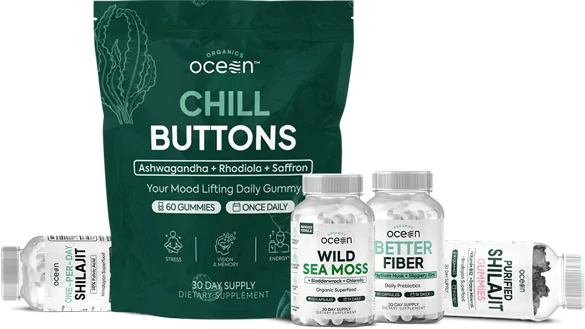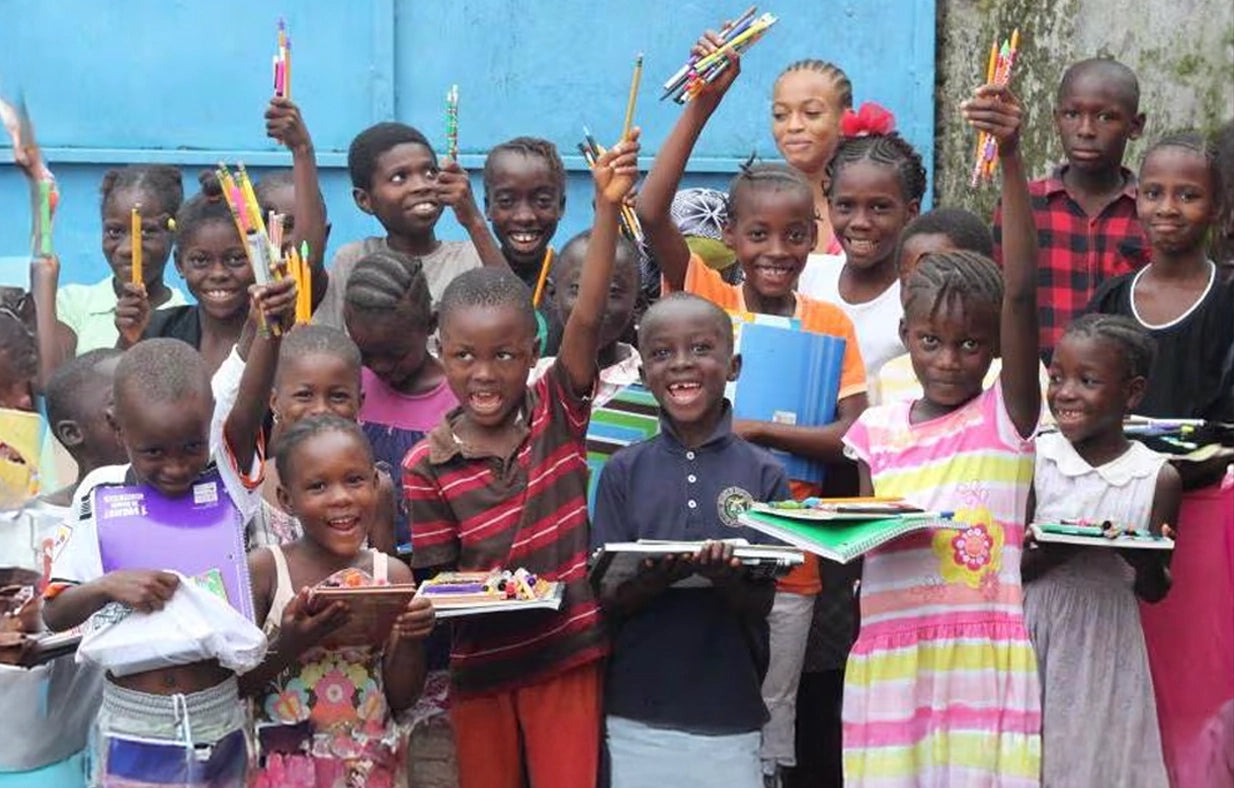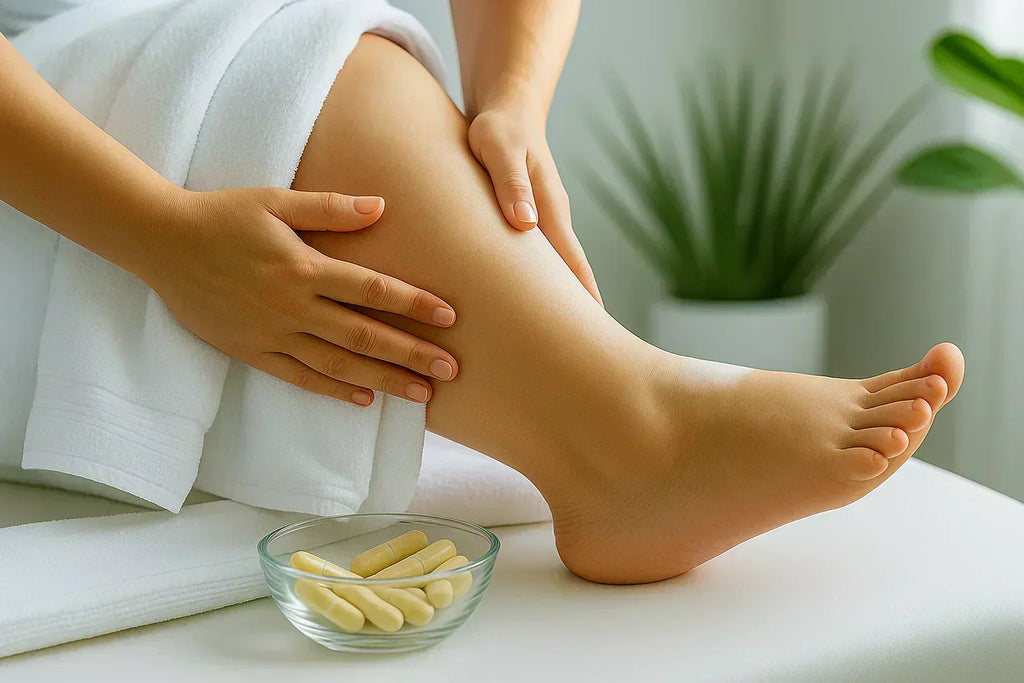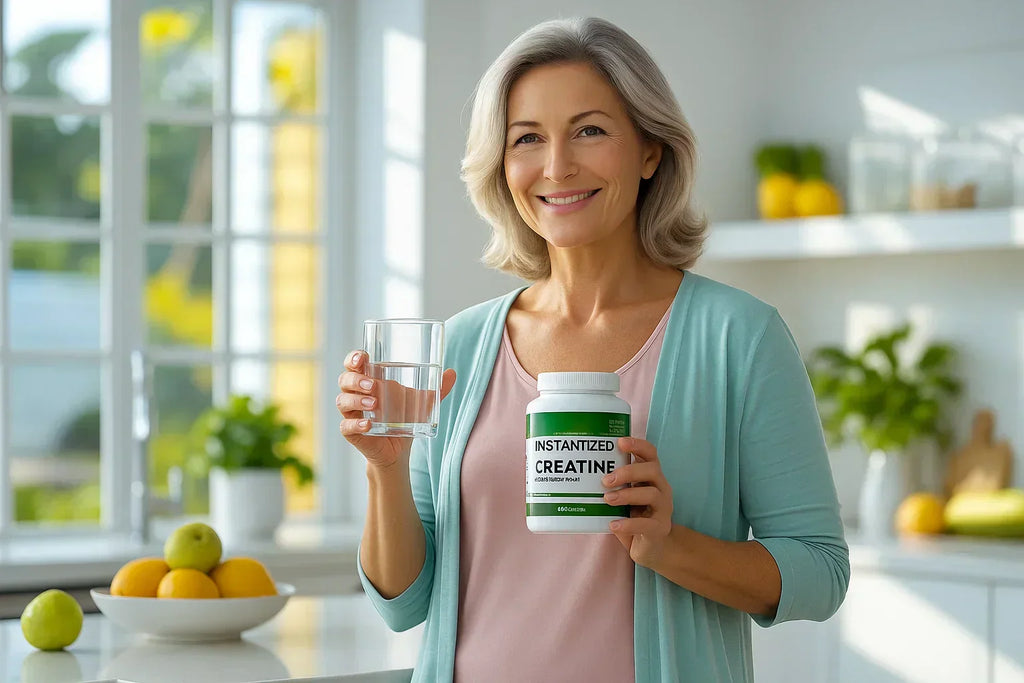How and when can I contact customer service?






See What Our Customers Have To Say

Aaron W.
Verified Purchaser
Vicki H
Verified Purchaser
Jill P
Verified Purchaser
Featured Products
Why 340,000+ customers trust Ocean

Save Big With Organics Ocean's Bundles
New Wellness Articles Weekly
Vitamin D deficiency can contribute to hair loss by disrupting the normal growth cycle of hair follicles. You might notice thinning, slow regrowth, or even patchy bald spots if your vitamin D levels are low. Studies show a connection between low vitamin D and certain types of alopecia, which means maintaining adequate levels is important for a healthy scalp.
Beyond the basics, research indicates that vitamin D works alongside other nutrients to support hair health. Combining vitamin D3 with K2 may offer added benefits because K2 helps your body use vitamin D more effectively and supports overall scalp health. If you’re looking to address hair loss, considering these nutrients together could make a difference.
Understanding how your body’s vitamin D status affects your hair can help you take practical steps to prevent or manage unwanted shedding. You’ll find out how to spot deficiency, ways to boost your intake, and what science says about supplements as you continue reading.
Understanding Vitamin D Deficiency and Its Impact on Hair Health
Vitamin D plays a significant role in hair follicle development and growth cycles. When your vitamin D levels fall below the recommended range, you may notice various changes in your hair health, including increased risk of shedding or thinning.
The Role of Vitamin D in Hair Follicle Function
Vitamin D helps your body regulate the lifecycle of hair follicles. Hair follicles are miniature organs in your skin that produce hair strands through a regulated growth cycle.
Vitamin D stimulates keratinocytes, the primary cells that form hair, skin, and nails. These cells rely on adequate vitamin D to function well and generate new hair follicles. A deficiency can interrupt this process, making it difficult for hair to regrow or stay healthy.
Clinical research shows that vitamin D is necessary for the creation of new hair follicles and for activating hair growth phases. This role becomes even more significant for people with chronic hair conditions.
How Vitamin D Deficiency Contributes to Hair Loss
Low vitamin D has been linked with several forms of hair loss, such as telogen effluvium and even autoimmune conditions like alopecia areata. Insufficient vitamin D makes it harder for your follicles to enter or sustain the growth phase, causing an uptick in hair thinning or shedding.
A lack of vitamin D can lead to a decrease in healthy hair follicle numbers. You may notice more hair in your brush or on your pillow when your intake is not enough. Some studies have shown a connection between chronic vitamin D deficiency and scarring alopecia, which may result in permanent hair loss if left unaddressed.
Vitamin D3, particularly combined with K2, is beneficial for improving hair loss because K2 helps with vitamin D metabolism and calcium regulation, making nutrients more bioavailable for your hair follicles.
Links Between Hair Thinning and Vitamin D Intake
Observational studies consistently find that individuals experiencing hair thinning often have low measured levels of vitamin D. This connection is more apparent in people with pattern hair loss or chronic diffuse thinning.
Vitamin D deficiency may cause hair loss in some people, making intake particularly important if you're prone to thinning hair. Vitamin D encourages the development of strong, healthy follicles and supports immune system functions that can lead to a reduction in inflammatory hair disorders.
Adding more vitamin D through sunlight exposure, food sources, or supplements like vitamin D3 with K2 can help support your hair health. If you suspect deficiency, a healthcare professional can guide you on proper intake to improve your hair's strength and fullness.
Common Types of Hair Loss Related to Vitamin D
Low vitamin D is associated with several forms of hair loss. Vitamin D plays a role in immune regulation, follicle health, and the hair growth cycle.
Alopecia Areata and the Immune System
Alopecia areata is an autoimmune condition, meaning your immune system mistakenly attacks hair follicles, causing patchy loss. Research indicates that people with alopecia areata tend to have lower serum vitamin D levels compared to those without the condition.
Vitamin D supports normal immune function and appears to help regulate immune activity around hair follicles. Insufficient levels can worsen the autoimmune response, increasing hair loss. Some studies also suggest a link between insufficient vitamin D and greater severity of alopecia areata.
Treatment approaches often involve:
- Correcting vitamin D deficiency
- Sometimes supplementing with a combination of vitamin D3 and K2, as K2 helps calcium absorb properly and may enhance the effect of D3
- Immune-modulating therapies
Telogen Effluvium and Shedding
Telogen effluvium involves excessive, diffuse shedding of hair, usually after stress, illness, or hormonal changes. This condition is also associated with low vitamin D levels. Vitamin D influences the hair cycle, particularly the transition from the resting (telogen) phase to the active growth (anagen) phase.
When your body is lacking vitamin D, more hair follicles may prematurely enter the shedding phase, increasing hair loss. Evidence suggests that restoring vitamin D levels can help normalize the hair cycle and reduce shedding associated with telogen effluvium.
- Common signs: Noticeable thinning all over the scalp, not just in patches.
- Action: Addressing vitamin D deficiency through diet, supplementation, and possibly pairing vitamin D3 with K2 for improved absorption.
For more details on the connection between vitamin D and telogen effluvium, clinical studies are available.
Aging and Hair Loss Patterns
As you age, hair naturally becomes thinner and growth slows, often described as androgenetic alopecia or pattern hair loss. While genetics play a central role, vitamin D continues to be important because healthy follicles depend on it.
Older adults are at increased risk for vitamin D deficiency due to reduced skin synthesis and dietary intake. Studies suggest that maintaining optimal vitamin D status may help support follicle function and slow age-related thinning.
Consider the following:
- Combine vitamin D3 and K2 supplements for better bone and follicle health.
- Monitor your vitamin D status through lab tests, especially if you notice gradual or patterned hair loss as you age.
You can read more about how vitamin D affects hair growth and aging-related hair loss.
Prevention and Management Strategies
Maintaining optimal vitamin D levels is important for supporting hair growth and minimizing hair loss. You can achieve this through thoughtful choices in diet, supplementation, and exposure to sunlight.
Dietary Sources of Vitamin D for Hair Growth
You can boost your vitamin D intake by incorporating specific foods into your diet. Fatty fish are among the richest natural sources. For example, mackerel and salmon are both excellent choices, with a typical 85-gram serving of salmon providing well over half the daily recommended intake for an adult.
Other options include fortified foods such as cow's milk, plant-based milks, breakfast cereals, and some types of yogurt. Animal-based products like egg yolks and cheese also provide small amounts.
A balanced diet that includes these foods supports healthy hair growth by supplying the body with vital nutrients, including vitamin D, which can be lacking in restrictive or plant-based diets.
Benefits and Risks of Vitamin D Supplements
When diet and lifestyle do not provide enough vitamin D, supplements are a practical solution. Vitamin D3 is the preferred form because it is more effective at raising blood vitamin D levels than D2. For hair loss, combining vitamin D3 with vitamin K2 can be advantageous, since K2 supports calcium balance and enhances the effectiveness of vitamin D3.
Short-term use of higher-dose supplements may be recommended if you have a deficiency, followed by a maintenance dose as advised by a healthcare professional. However, it is important not to exceed the recommended dose since too much vitamin D can cause adverse effects, including elevated blood calcium levels.
Consult your doctor before starting supplements, especially if you have underlying health conditions or take other medications.
Sun Exposure and Safe Vitamin D Synthesis
Your skin naturally makes vitamin D when exposed to sunlight, specifically UVB rays. A moderate amount of sun exposure—such as 10 to 30 minutes several times a week, depending on skin type, location, and weather—helps maintain healthy vitamin D levels, which are linked with supported hair follicle function.
During winter months or in regions with limited sunlight, it may become harder to meet your needs through sun exposure alone. In these cases, dietary sources and supplements become more important.
To avoid risks such as sunburn or increased skin cancer risk, wear protective clothing and sunscreen after the initial exposure period. Aim for safe sun habits that maintain vitamin D synthesis while minimizing potential skin damage. For more information, check Medical News Today on vitamin D deficiency and hair loss.
Recognizing Symptoms and Seeking Professional Help
Vitamin D deficiency can impact many aspects of your health, from causing fatigue to affecting immune function and hair growth. Recognizing when to seek care and understanding your rights during treatment helps you take control of your health.
Identifying Early Signs of Fatigue and Deficiency
Early symptoms of vitamin D deficiency often include fatigue, unexplained weakness, and sometimes mood changes such as low mood or irritability. Hair loss, particularly gradual thinning and a noticeable decrease in hair volume, has also been linked to low vitamin D levels. Individuals with deficiency might notice increased hair shedding or slower hair regrowth.
You may also experience more frequent illnesses due to the effect of vitamin D on immune health. People with darker skin, limited sun exposure, or certain dietary restrictions may be more prone to low vitamin D. Using a supplement that combines vitamin D3 with K2 might be especially effective for hair loss, as K2 helps with calcium absorption, further supporting overall health.
When to Consult With a Healthcare Provider
If you notice persistent fatigue, declining energy, unexplained hair loss, or a higher frequency of illness, it is important to consult a healthcare provider. Tests for vitamin D levels are straightforward and can help guide appropriate supplementation or treatment. Early treatment can prevent complications and improve your well-being.
It is important to discuss all your symptoms—not just hair loss—as vitamin D plays roles beyond hair growth, including bone strength and immune support. Bring a clear list of symptoms to your appointment to ensure that your concerns are addressed promptly and accurately. For further details on symptoms, see this overview on how to spot a vitamin D deficiency.
Understanding Consent and Abuse in Medical Care
When consulting with any healthcare provider, your consent is required before tests or treatments are performed. Providers must inform you about the benefits, risks, and alternatives for any procedure or supplement. If you feel pressured, ignored, or mistreated, this may indicate a breach of professional boundaries and can be considered abuse.
You have the right to seek a second opinion if you are uncomfortable or feel your concerns about vitamin D deficiency and hair loss are not taken seriously. Reporting inappropriate behavior is important to ensure safe, ethical care for yourself and others. Always prioritize your comfort and consent throughout the medical consultation and treatment process.
Frequently Asked Questions

Vitamin D deficiency has been linked to problems with hair growth and hair loss. Addressing this deficiency can sometimes help restore normal hair health, but results depend on the underlying cause and how soon it is corrected.
How can vitamin D levels affect hair growth?
Vitamin D interacts directly with hair follicles and helps regulate their growth cycle. Low vitamin D can disrupt this cycle, leading to thinning or increased shedding. Maintaining adequate levels supports healthy follicle function and hair growth.
Is hair loss due to vitamin D deficiency reversible?
Hair loss caused specifically by vitamin D deficiency can often be reversed with proper supplementation. Once your vitamin D levels are restored, hair follicles may gradually return to normal functioning and regrow hair. This process can take several months and varies by individual.
What methods are recommended for using vitamin D to support hair health?
You can support hair health by taking vitamin D supplements, eating foods rich in vitamin D, and getting regular sunlight exposure. Many people benefit from taking a combination of vitamin D3 and K2, as K2 supports proper calcium metabolism, potentially reducing the risk of calcium buildup in the scalp.
Can increasing vitamin D intake help stop hair loss?
Increasing your vitamin D intake may help slow or stop hair loss if it is related to deficiency. Studies show that vitamin D supplementation can help resolve hair loss in those who are deficient. However, not all forms of hair loss are caused by low vitamin D.
What are the typical symptoms of a vitamin D deficiency?
Common symptoms include fatigue, muscle weakness, bone pain, and frequent illness. Hair loss is also a known symptom, especially when other signs of deficiency are present. Blood tests are needed to confirm low vitamin D levels.
What is the advisable dosage of vitamin D for someone deficient and experiencing hair loss?
Deficient adults are typically prescribed 1,000 to 2,000 IU of vitamin D3 daily, but your healthcare provider may recommend a higher dose based on your blood test results. It’s often advised to combine D3 with K2 to optimize absorption and calcium balance. You should not self-prescribe high doses without medical supervision.
Leg cramps can strike without warning, leaving you searching for fast relief and wondering which supplement might help prevent future episodes. Magnesium glycinate stands out as the most effective form of magnesium for leg cramps due to its high absorption rate and gentle effect on the digestive system.
The connection between magnesium deficiency and muscle cramping is well-established, but choosing the right type of magnesium can make the difference between finding relief and wasting your money. Different forms of magnesium offer varying levels of bioavailability and potential side effects.
Understanding how magnesium works in your muscles, which specific forms provide the best results, and what factors to consider when selecting a supplement will help you make an informed decision. You'll also discover additional nutrients and strategies that work alongside magnesium to reduce the frequency and intensity of leg cramps.
How Magnesium Helps With Leg Cramps
Magnesium acts as a natural muscle relaxant by regulating calcium flow in muscle cells and supporting proper nerve signaling. When magnesium levels drop, muscles become more prone to painful contractions and involuntary spasms.
Role of Magnesium in Muscle and Nerve Function
Magnesium controls calcium movement across cell membranes in your muscles. When you have adequate magnesium, it blocks excess calcium from entering muscle cells during relaxation phases.
Calcium-Magnesium Balance:
- Calcium triggers muscle contraction
- Magnesium enables muscle relaxation
- Imbalance leads to sustained contractions
Your nerves rely on magnesium to transmit electrical signals properly. Low magnesium disrupts nerve communication, causing erratic muscle firing patterns.
Magnesium activates over 300 enzymes involved in muscle metabolism. These enzymes convert nutrients into energy your muscle cells need for normal contraction and relaxation cycles.
The mineral also maintains proper electrolyte balance alongside sodium and potassium. This balance keeps your muscle cells stable and prevents the hyperexcitability that triggers cramps.
Magnesium's Effect on Muscle Cramp Relief
Magnesium works as a natural muscle relaxant by counteracting calcium's contracting effects. When you take magnesium, it competes with calcium at binding sites on muscle fibers.
Your muscles need magnesium to produce ATP, the primary energy source for cellular functions. Without sufficient ATP production, muscles cannot complete proper relaxation sequences.
Key Relief Mechanisms:
- Reduces muscle cell excitability
- Normalizes nerve impulse transmission
- Decreases inflammatory responses
- Improves blood flow to cramped areas
Magnesium supplementation typically takes 2-4 weeks to build tissue levels high enough for cramp prevention. The mineral accumulates in muscle and bone tissue over time.
Research shows magnesium may be particularly effective for nighttime leg cramps that occur during rest periods when muscle metabolism slows.
Magnesium Deficiency and Muscle Spasms
Magnesium deficiency is one possible reason for leg cramps, affecting up to 15% of the general population. Your body cannot produce magnesium, so you must obtain it through diet or supplements.
Common Deficiency Causes:
- Poor dietary intake
- Chronic stress
- Excessive alcohol consumption
- Certain medications (diuretics, proton pump inhibitors)
- Digestive disorders affecting absorption
Early deficiency symptoms include muscle twitches, cramping, and increased muscle tension. As levels drop further, you may experience more frequent and intense muscle spasms.
Your kidneys normally regulate magnesium excretion, but various factors can increase losses. Sweating during exercise depletes magnesium along with other electrolytes.
Blood tests often miss magnesium deficiency because only 1% of total body magnesium circulates in blood. Most magnesium stays stored in bones and soft tissues, making functional deficiency difficult to detect through standard testing.
Best Types of Magnesium for Leg Cramp Relief

Different forms of magnesium offer varying absorption rates and effectiveness for muscle cramp relief. Magnesium glycinate stands out as the top choice due to its superior bioavailability and gentle digestive profile.
Magnesium Glycinate for Muscle Relaxation
Magnesium glycinate combines magnesium with the amino acid glycine, creating a chelated form that your body absorbs more efficiently than other magnesium supplements. This form typically causes fewer digestive side effects compared to other varieties.
The glycine component provides additional benefits for muscle relaxation and sleep quality. Glycine acts as an inhibitory neurotransmitter that helps calm your nervous system.
Key Benefits:
- High absorption rate - up to 90% bioavailability
- Minimal digestive upset - gentle on your stomach
- Enhanced muscle relaxation - glycine supports nerve function
- Better sleep support - promotes restful sleep patterns
You can typically take 275 mg of elemental magnesium from glycinate daily. This form works best for leg cramps because it reaches your muscle tissue effectively without causing diarrhea.
Magnesium Citrate for Bioavailability
Magnesium citrate binds magnesium to citric acid, creating a highly bioavailable form that your digestive system readily absorbs. This form dissolves easily in water and enters your bloodstream quickly.
The citrate form provides good value for money while delivering effective results for muscle cramps. However, it can cause loose stools at higher doses due to its laxative properties.
Absorption Characteristics:
- Fast-acting - enters bloodstream within 1-2 hours
- Water-soluble - dissolves completely in liquids
- Moderate cost - affordable option for daily use
Start with 200 mg daily and adjust based on your tolerance. Take magnesium citrate with food to minimize digestive effects. This form offers excellent bioavailability for those who can tolerate its mild laxative effect.
Comparing Magnesium Oxide and Other Forms
Magnesium oxide contains the highest percentage of elemental magnesium per dose but has poor absorption rates of only 4-10%. Your body struggles to break down this form effectively.
Absorption Comparison:
| Magnesium Form | Absorption Rate | Digestive Impact |
|---|---|---|
| Glycinate | 80-90% | Minimal |
| Citrate | 60-70% | Moderate |
| Oxide | 4-10% | High |
Other forms like magnesium chloride and magnesium malate offer moderate absorption with specific benefits. Chloride works well topically, while malate may support energy production.
Magnesium supplements vary significantly in their effectiveness for leg cramps based on how well your body can utilize them. Choose forms with higher bioavailability for better muscle cramp relief.
Factors to Consider When Choosing a Magnesium Supplement

Selecting the right magnesium supplement requires evaluating absorption rates, proper dosing, potential side effects, and beneficial ingredient combinations. These factors directly impact how effectively the supplement addresses your leg cramps.
Absorption and Bioavailability
The form of magnesium determines how much your body actually absorbs and uses. Magnesium glycinate stands out for its high absorption rates compared to other forms.
Highly Absorbable Forms:
- Magnesium glycinate (chelated with glycine)
- Magnesium malate (bound with malic acid)
- Magnesium citrate (citric acid bound)
Lower Absorption Forms:
- Magnesium oxide
- Magnesium sulfate
- Magnesium carbonate
Forms known for bioavailability, like magnesium glycinate for better results for muscle cramps. Chelated forms bind magnesium to amino acids, protecting it from stomach acid interference.
Your digestive system processes chelated magnesium more efficiently. This means less magnesium waste and better cramp prevention with smaller doses.
Supplement Dosage and Form
Magnesium supplements come in capsules, tablets, powders, and liquid forms. Each delivery method affects absorption speed and convenience. Start with lower doses to assess tolerance. Most people see cramp improvement with 200-275 mg daily, taken with food.
Form Considerations:
- Capsules dissolve faster than tablets
- Powders mix into drinks for easier consumption
- Liquid forms absorb quickly but may taste unpleasant
Time-release formulations provide steady magnesium levels throughout the day. This consistent availability helps prevent the magnesium dips that trigger leg cramps.
Potential Side Effects and Safety
Magnesium supplements generally cause few side effects when taken appropriately. Digestive issues represent the most common problems with certain forms.
Common Side Effects:
- Loose stools or diarrhea
- Stomach cramping
- Nausea
- Bloating
Magnesium oxide causes more digestive upset than glycinate or malate forms. Taking supplements with meals reduces stomach irritation.
Safety Considerations:
- Kidney disease patients need medical supervision
- High doses (over 350 mg supplemental) may cause diarrhea
- Interactions possible with certain antibiotics and medications
People with heart conditions should consult healthcare providers before starting magnesium supplements. The mineral affects heart rhythm and blood pressure.
Additional Ingredients for Enhanced Effectiveness
Some magnesium supplements include complementary ingredients that boost effectiveness for leg cramps. These combinations target multiple aspects of muscle function and sleep quality.
Beneficial Additions:
- Vitamin D3: Improves magnesium absorption and bone health
- Calcium: Works with magnesium for proper muscle contraction
- Potassium: Supports electrolyte balance and muscle function
- B-complex vitamins: Aid energy metabolism in muscle cells
Malic acid enhances magnesium absorption while supporting cellular energy production. This combination particularly benefits people with chronic muscle pain or fatigue.
Sleep and Recovery Enhancers:
- Melatonin for nighttime cramp prevention
- L-theanine for relaxation
- Glycine for better sleep quality
Avoid supplements with unnecessary fillers, artificial colors, or excessive additives. These ingredients don't improve effectiveness and may cause sensitivities in some people.
Additional Strategies and Key Nutrients for Preventing Leg Cramps
While magnesium plays a crucial role in muscle function, maintaining proper electrolyte balance through potassium and calcium intake, staying adequately hydrated, and recognizing when professional medical guidance is needed form the foundation of comprehensive cramp prevention.
Importance of Potassium and Calcium Balance
Potassium works alongside magnesium to regulate muscle contractions and prevent cramping. Your muscles need adequate potassium levels to maintain proper electrical conductivity and fluid balance within muscle cells.
Nutritional deficiencies in potassium, magnesium, and calcium can directly connect to muscle fatigue and spasms. When potassium levels drop, your muscles become more susceptible to involuntary contractions.
Calcium serves as the trigger for muscle contractions, while magnesium helps muscles relax. This delicate balance between calcium and magnesium determines whether your muscles can contract and release smoothly.
Key daily intake recommendations:
- Potassium: 2,600-3,400 mg
- Calcium: 1,000-1,200 mg
- Magnesium: 200-400 mg
Foods rich in potassium include bananas, sweet potatoes, and spinach. Dairy products, leafy greens, and fortified plant milks provide calcium. Certain foods and drinks with electrolyte minerals like potassium and magnesium can help prevent leg and muscle cramps.
Hydration and Lifestyle Modifications
Dehydration can upset the balance of electrolytes, leading to cramps. Your muscles require proper hydration to maintain electrolyte balance and facilitate nutrient transport.
Aim for 8-10 glasses of water daily, increasing intake during exercise or hot weather. Sports drinks containing electrolytes can help during prolonged physical activity lasting over one hour.
Lifestyle modifications that reduce leg cramps:
- Stretch before and after exercise
- Warm up gradually before physical activity
- Avoid prolonged sitting or standing
- Wear proper footwear with adequate support
- Maintain regular sleep patterns
Temperature extremes can trigger muscle cramps. Keep your legs warm in cold conditions and ensure adequate cooling during hot weather. Gentle massage and heat application can help relax tense muscles before sleep.
When to Seek Medical Advice
Consult your healthcare provider if leg cramps occur more than three times per week or persist despite dietary and lifestyle changes. Frequent cramping may indicate underlying medical conditions requiring professional evaluation.
Seek immediate medical attention for:
- Severe pain lasting more than 10 minutes
- Swelling or redness in the affected leg
- Weakness or numbness following cramps
- Cramps accompanied by fever
Certain medications can increase cramping frequency, including diuretics, statins, and blood pressure medications. Your doctor can adjust dosages or suggest alternatives if medications contribute to your symptoms.
Frequent muscle cramps may occur if you have a magnesium deficiency or deficiencies in other nutrients. Blood tests can identify specific nutrient deficiencies that supplements alone cannot address adequately.
Frequently Asked Questions
Magnesium glycinate stands out as the top choice for leg cramp relief due to its superior absorption rates. The recommended dosage typically ranges from around 200-275 mg daily, though individual needs vary based on deficiency levels and body weight.
What form of magnesium is most effective for treating leg cramps?
Magnesium glycinate is considered the best form for leg cramps among the 11 available types. This form offers high absorption rates and includes glycine, which enhances its effectiveness.
Magnesium citrate provides another well-absorbed option that works effectively for muscle cramping. Magnesium chloride also shows promise for reducing cramp frequency and intensity.
The chelated forms like glycinate tend to cause fewer digestive side effects compared to other varieties. Your body can utilize these forms more efficiently for muscle function.
How can magnesium glycinate improve sleep and reduce leg cramps?
Magnesium glycinate contains glycine, an amino acid that promotes relaxation and better sleep quality. This dual action addresses both nighttime leg cramps and sleep disturbances simultaneously.
The glycine component helps calm your nervous system and prepare your body for rest. Better sleep quality often correlates with reduced muscle tension and cramping episodes.
This form absorbs well without causing the laxative effects common with other magnesium types. You can take it before bedtime without digestive discomfort.
What dietary sources are rich in magnesium to help alleviate leg cramps?
Dark leafy greens like spinach and Swiss chard provide excellent magnesium content. Nuts and seeds, particularly almonds, pumpkin seeds, and cashews, offer concentrated amounts.
Whole grains including quinoa, brown rice, and oats contribute meaningful magnesium to your daily intake. Legumes such as black beans, chickpeas, and lentils also supply this essential mineral.
Avocados, dark chocolate, and fatty fish like salmon provide additional dietary magnesium. These whole food sources offer better absorption than some supplement forms.
What is the recommended dosage of magnesium for alleviating leg cramps?
Most adults benefit from 200-275 mg of elemental magnesium daily for cramp prevention. Start with lower doses around 200 mg to assess your tolerance and response.
Pregnant women may need higher amounts, but should consult their healthcare provider first. Individual requirements vary based on existing deficiency levels and overall health status.
Take magnesium with food to improve absorption and reduce potential digestive upset. Splitting doses throughout the day often works better than taking one large amount.
Is magnesium or potassium more efficacious in treating leg cramps?
Both minerals play crucial roles in muscle function, but they work through different mechanisms. Magnesium helps muscles relax, while potassium supports proper muscle contraction.
Magnesium deficiency more commonly triggers muscle cramping than potassium deficiency in most people. However, some individuals may need both minerals for optimal results.
Your specific deficiency determines which mineral will provide better relief. Blood tests can help identify which nutrient you may be lacking.
Can topical magnesium sprays provide relief for leg cramps, and which are recommended?
Topical magnesium sprays and oils can provide localized relief when applied directly to cramping muscles. These products allow magnesium to absorb through your skin for targeted action.
Magnesium chloride forms the basis for most effective topical products. Apply these sprays or oils to clean skin on the affected leg muscles before bedtime.
Some people experience better results combining topical application with oral supplementation. The transdermal absorption bypasses digestive issues that some oral forms may cause.
Creatine can help you maintain muscle, improve strength, and potentially support bone and brain health during menopause. As hormone levels change, your body naturally loses some of its muscle and bone mass, leading to more aches, fatigue, and challenges with daily activities. Researchers and health experts have found that creatine supplementation may help offset these changes, especially when paired with regular strength training.
This supplement is not just for athletes or bodybuilders—women experiencing menopause can benefit from creatine, too. Recent studies suggest that it can make a noticeable difference in your energy levels, lean body mass, and even your mood and memory as you age. Learn how adding creatine to your routine could support your overall health in the years ahead and what you need to know before starting.
Understanding Menopause and Muscle Health
During menopause, shifting hormones affect almost every part of your body, widely impacting muscle mass and bone strength. The stages of perimenopause and post-menopause bring notable changes that directly influence your muscle function and risk for bone-related issues like osteoporosis.
Hormonal Changes and Their Impact
Estrogen and testosterone levels begin to decline as you approach menopause. These hormones play vital roles in maintaining lean muscle and bone density. Reduced estrogen can result in more pronounced menopause symptoms, such as hot flashes, fatigue, and joint pain, which may affect your daily routines and physical activity levels.
A drop in estrogen also slows your body’s ability to repair and build muscle tissue. This hormonal shift often leads to increased fat mass and reduced muscle strength. You may find it harder to maintain your usual exercise performance, and recovery from workouts can take longer during post-menopausal years.
Muscle Mass and Sarcopenia in Menopausal Women
Loss of muscle mass, known as sarcopenia, accelerates as you age, particularly during and after menopause. Lower estrogen and testosterone further compound this process, making it harder to preserve or build muscle. Inactive lifestyles and inadequate protein intake can worsen the decline.
Sarcopenia not only reduces muscle strength but can also detract from your mobility and metabolic health. You may notice less endurance, weaker grip strength, and increased difficulty performing everyday tasks. Resistance training and specific nutrition strategies become even more critical during menopause to help retain and rebuild lean muscle.
Bone Density and Osteoporosis Risk
Menopausal changes put women at a higher risk for decreased bone density and osteoporosis. Estrogen is essential for bone health, aiding in calcium absorption and slowing bone breakdown. When estrogen drops, you can lose bone mass more rapidly, increasing the likelihood of fractures and osteoporosis.
Post-menopausal women and older adults need to be particularly vigilant about bone health. Activities that promote bone loading, like strength training, and nutrients such as calcium and vitamin D, play key roles in protecting bone mass. Exploring interventions shown to support bone strength can make a significant difference in reducing fracture risk and boosting overall bone resilience.
Creatine Supplementation for Menopausal Women
Creatine is a dietary supplement that plays a critical role in supporting muscle, bone, and cognitive health—areas frequently impacted during menopause. Current research highlights its effects on energy metabolism, mood, and physical function, making it a potential ally for women navigating menopausal changes.
How Creatine Works in the Body
Creatine, most commonly supplemented as creatine monohydrate, is naturally present in your muscles and brain. It supports the formation of adenosine triphosphate (ATP), the main energy currency in your cells.
During short bursts of physical activity, creatine rapidly recharges ATP to fuel muscle contractions. This function helps maintain performance during resistance training and high-intensity exercise. For women in menopause, this energy support may become more important as metabolism and muscle mass naturally decline.
The typical creatine dosage involves either a loading phase (20 grams per day, split into 4 doses, for 5–7 days) or a maintenance phase (about 3–5 grams per day). A traditional loading protocol can lead to quicker saturation of muscle stores, but a daily maintenance dose is sufficient for most long-term goals.
Benefits of Creatine During Menopause
Menopausal women often experience reduced muscle mass, decreased bone density, and increased muscular fatigue. When paired with resistance training, creatine supplementation has been shown to help increase lean mass, improve muscle strength, and enhance recovery by supporting protein synthesis and ATP production.
Studies show that consistent supplementation can aid in maintaining or even improving bone mineral density, particularly when combined with exercise. This is significant given the elevated risk of osteoporosis after menopause. Creatine may also reduce muscular fatigue and improve overall exercise performance, helping you stay active and independent as you age. For more specifics, see how creatine counters muscle and bone loss in menopausal women.
Cognitive Health and Mood Support
Cognitive decline and mood swings are common concerns during and after menopause. Emerging evidence suggests that creatine not only supports physical performance but may also benefit brain health. By enhancing energy supply in brain cells, creatine potentially combats symptoms like brain fog, memory lapses, and reduced attention.
Several studies indicate improvements in working memory, mental sharpness, and cognitive performance, especially during periods of stress or sleep deprivation. Some research has even shown a positive effect on symptoms of depression and mental fatigue in women experiencing menopause, which may help mitigate challenges related to mental health.
Safety and Common Myths
Creatine is one of the most studied dietary supplements and is generally considered safe for healthy adults when taken at recommended doses. Concerns about kidney function have not been supported by research in individuals without pre-existing kidney disease. Hydration is important, as increased water retention in muscles can occur, but the risk of dehydration is low with adequate fluid intake.
Common myths include claims of creatine acting as an anabolic steroid, causing hair loss, or leading to dangerous bloating. Creatine is not a steroid but a naturally occurring compound. Any weight gain is typically due to water retention, not fat accumulation. Most users experience minimal side effects, and bloating usually resolves with a lower maintenance dose.
Optimizing Results with Creatine
For women in menopause, creatine supplementation can support muscle recovery, strength gains, and better body composition. Maximizing its benefits depends on how you integrate it with workouts, nutrition, and a thoughtful dosing plan.
Combining Creatine with Strength Training
Pairing creatine with strength training increases muscle strength, lean body mass, and exercise capacity. Creatine works best when you follow a consistent resistance program, such as weightlifting, bodyweight exercises, or plyometric training. Focus on major muscle groups and progressive overload—gradually increasing the resistance or intensity over time.
Many studies show that creatine improves muscle recovery and reduces muscle damage after intense sessions. Try to plan regular recovery days and varied workouts to support consistent progress. Resistance training combined with creatine can help preserve or increase lean body mass, which is especially important during menopause when muscle loss is common. This strategy may also promote improvements in sports performance and overall well-being.
Supporting Nutrition and Healthy Lifestyle
Adequate nutrition is essential when using creatine. You should prioritize protein-rich foods such as lean meats, eggs, legumes, and dairy for optimal muscle support. Creatine is especially helpful for vegetarians since their dietary intake is typically lower, as highlighted by research on creatine supplementation in women's health.
Pair creatine with a healthy lifestyle: proper hydration, balanced meals, and regular exercise. Pay attention to sleep quality, since sleep deprivation can slow muscle recovery and adaptation. Focus on heart health with sources of healthy fats and fiber. This comprehensive approach can help manage fat mass and support a faster metabolism, minimizing the risk of unwanted weight gain during menopause.
Best Practices for Dosing and Loading
A typical creatine dosage is 3–5 grams per day. You may start with a loading phase—taking 20 grams broken into four doses daily for five to seven days—to saturate your muscles faster. After this, continue with a maintenance dose of 3–5 grams daily.
Skipping the loading phase and taking the smaller daily dose is also effective, but results may take a few extra weeks to appear. Stay consistent with dosing to maintain benefits, and remember to drink plenty of water to reduce the risk of digestive discomfort. Review your supplementation plan with a healthcare or functional medicine professional if you have any chronic health conditions or specific concerns about heart health or metabolism. This protects your safety while allowing you to optimize the positive effects of creatine during menopause, as explained in the Menopause Dietitian's overview of creatine benefits.
Frequently Asked Questions
Creatine is widely studied for its effects on muscle health, brain function, and energy metabolism during menopause. Understanding its impacts, side effects, and forms is important for making informed decisions.
What are the potential side effects of using creatine for postmenopausal women?
Most research shows creatine is generally safe for healthy adults, including postmenopausal women when used at recommended doses (3–5 grams per day). Mild side effects like water retention or stomach upset may occur in some people. Serious side effects are rare, but it's advised to consult your healthcare provider before starting supplementation.
Can creatine supplementation help alleviate menopausal brain fog?
Emerging evidence suggests creatine may support cognitive function and help with problems like mental fatigue or decreased clarity. Some studies have shown improved performance on demanding cognitive tasks and potential for better mood regulation in women during menopause. These effects are linked to creatine’s ability to support brain energy metabolism and neurotransmitter function.
What are the benefits and drawbacks of creatine use for women during menopause?
Creatine can help maintain or improve muscle strength, reduce age-related muscle loss, and may also benefit bone mineral density, especially when paired with strength training. Mood improvements and enhanced brain health are additional possible benefits.
Drawbacks are typically minimal but can include mild gastrointestinal discomfort or water retention. Creatine is not known to cause significant harm when used within recommended dosages.
How does creatine affect hormones in women going through menopause?
Current evidence indicates creatine does not significantly alter hormone levels in women, including estrogen or progesterone. Instead, it may help counteract some hormone-related impacts such as muscle and bone loss, which are common during and after menopause. The interaction between creatine and female hormones continues to be studied. More on hormonal effects can be reviewed at PMC's Lifespan Perspective.
Is creatine monohydrate the recommended form of creatine for women over 50?
Creatine monohydrate is the most extensively researched and recommended form for adults, including women over 50. It is cost-effective, safe, and consistently shown to support muscle and cognitive health. Alternative forms of creatine have not demonstrated clear advantages over monohydrate for menopausal women. Execution guidelines and dosing for women are discussed at JoinMidi.
Are there specific types of creatine more suitable for women experiencing perimenopause?
No specific types of creatine have been proven more effective for women in perimenopausal or menopausal stages than creatine monohydrate. Since it is the best-studied and most reliable form, it remains the primary choice recommended by researchers and clinicians for women navigating menopause or perimenopause.
Shilajit, a mineral-rich substance formed in the Himalayan mountains over centuries, offers unique health benefits specifically tailored to women's wellness needs. This ancient remedy can help address common female health concerns including low energy, hormonal imbalances, anemia, and reproductive health issues through its high concentration of fulvic acid and essential minerals.
You may have heard claims about shilajit's benefits, but understanding how it specifically works in your body as a woman requires looking at the science behind its mechanisms. The compound's ability to enhance nutrient absorption and support cellular energy production makes it particularly relevant for addressing the fatigue and nutritional deficiencies that many women experience.
From boosting energy levels and mental clarity to supporting hormonal balance during different life stages, shilajit presents several evidence-based applications for female health. You'll discover how this supplement works within your body's systems, what benefits you can realistically expect, and how to use it safely as part of your wellness routine.
How Shilajit Works in Female Health
Shilajit functions through its unique molecular composition and traditional preparation methods that enhance nutrient absorption and cellular function. The fulvic acid and essential minerals work together to support various biological processes specific to women's health needs.
What Is Shilajit?
Shilajit is a tar-like resin that forms over centuries from decomposed plant matter in high-altitude mountain ranges. The substance emerges from rock crevices in the Himalayas during warmer months when the heat causes it to soften and seep out.
This natural substance has been used in Ayurveda for over 3,000 years and contains over 80 different minerals in ionic form. The formation process involves microbial action and geological pressure that transforms organic matter into a concentrated mineral-rich compound.
Shilajit resin appears as a dark brown or black sticky substance with a distinctive smell. The authentic material dissolves completely in warm water, creating a golden-brown solution that indicates proper quality and purity.
Key Compounds: Fulvic Acid and Trace Minerals
Fulvic acid serves as the primary active compound in shilajit, typically comprising 15-20% of the total composition. This organic acid acts as a natural chelator that binds to minerals and nutrients, making them more bioavailable to your cells.
The fulvic acid component enhances cellular permeability, allowing nutrients to cross cell membranes more effectively. This process improves mitochondrial function and energy production at the cellular level, which directly impacts your daily energy levels.
Trace minerals in shilajit include:
- Iron for hemoglobin production
- Zinc for hormone regulation
- Magnesium for bone health
- Copper for collagen synthesis
- Selenium for antioxidant protection
These minerals exist in ionic form, meaning they're already broken down for optimal absorption. Your body can utilize these nutrients immediately without requiring additional digestive processes.
Shilajit in Ayurvedic Medicine
Ayurvedic medicine classifies shilajit as a rasayana, meaning it supports longevity and vitality. Traditional practitioners use it to balance the three doshas (vata, pitta, kapha) and strengthen ojas, the essence of immunity and vitality.
In Ayurvedic texts, shilajit is called "destroyer of weakness" and "conqueror of mountains." These names reflect its traditional use for enhancing physical strength and mental clarity in women facing various life stages.
The preparation methods in Ayurvedic medicine involve purification processes that remove heavy metals and impurities. This processing ensures safety while maintaining the beneficial properties of the raw material.
Traditional dosing follows specific guidelines based on individual constitution and health needs. Ayurvedic practitioners typically recommend consuming processed shilajit with warm milk or water for optimal absorption and digestive compatibility.
Energy, Mental Clarity, and Fatigue Relief
Shilajit provides natural support for energy production through enhanced cellular function and improved nutrient absorption. The supplement helps reduce mental fatigue while supporting clearer thinking and sustained focus throughout the day.
Combating Low Energy and Fatigue
Shilajit addresses low energy by optimizing your body's natural energy production processes. The fulvic acid content helps transport nutrients more effectively to your cells.
Key mechanisms for energy support:
- Enhanced nutrient absorption at the cellular level
- Improved oxygen utilization in tissues
- Better conversion of food into usable energy
- Reduced cellular waste accumulation
Your energy levels can improve within days to weeks of consistent use. Many women report feeling less afternoon fatigue and more sustained energy without the crashes associated with caffeine.
The mineral content in shilajit, including iron and B vitamins, supports healthy red blood cell function. This helps combat fatigue related to nutrient deficiencies common in women.
Enhancing Mitochondrial Function
Mitochondrial function receives significant support from shilajit's unique compounds. These cellular powerhouses produce ATP, your body's primary energy currency.
Shilajit helps protect mitochondria from oxidative stress damage. The antioxidants neutralize harmful free radicals that can impair cellular energy production.
Mitochondrial benefits include:
- Increased ATP synthesis efficiency
- Better cellular repair mechanisms
- Enhanced energy output capacity
- Improved cellular longevity
Research shows that shilajit can boost ATP production, which directly translates to more available energy for daily activities. Your cells function more efficiently when mitochondria receive proper nutritional support.
The dibenzo-alpha-pyrones in shilajit specifically target mitochondrial health. These compounds help maintain optimal energy production even during periods of increased physical or mental demands.
Reducing Brain Fog and Improving Focus
Brain fog often results from poor cellular energy production and oxidative stress in neural tissues. Shilajit addresses both underlying causes effectively.
Your mental clarity improves as brain cells receive better energy support. The enhanced mitochondrial function translates directly to sharper cognitive performance.
Cognitive improvements you may experience:
- Clearer thinking and decision-making
- Better memory recall and formation
- Increased mental stamina
- Reduced afternoon mental fatigue
The fulvic acid helps deliver nutrients across the blood-brain barrier more efficiently. This ensures your brain receives the minerals and compounds needed for optimal function.
Mental clarity benefits often become noticeable within the first few weeks of use. Your ability to concentrate during demanding tasks typically shows marked improvement.
Shilajit also supports neurotransmitter balance, which affects mood and cognitive function. This dual action on energy and brain chemistry creates comprehensive mental performance support.
Hormone and Libido Support for Women
Shilajit contains bioactive compounds that interact with the female endocrine system to promote hormonal equilibrium and enhance sexual wellness. The mineral-rich resin supports natural hormone production while addressing common issues like low libido and reproductive health challenges.
Balancing Female Hormones
Shilajit provides essential minerals and fulvic acid that support your body's natural hormone production. These compounds help regulate estrogen and progesterone levels throughout your menstrual cycle.
The trace minerals in shilajit, including zinc and magnesium, serve as cofactors for hormone synthesis. Your endocrine glands require these nutrients to produce hormones effectively.
Key hormonal benefits include:
- Reduced PMS symptoms
- More regular menstrual cycles
- Decreased mood swings
- Better sleep quality during hormonal fluctuations
Research suggests that shilajit's ability to balance hormones may help women experiencing perimenopause and menopause. The adaptogenic properties help your body respond better to hormonal stress.
Supporting the Endocrine System
Your endocrine system consists of glands that produce and regulate hormones throughout your body. Shilajit supports multiple glands including the ovaries, adrenals, and thyroid.
The fulvic acid in shilajit enhances cellular nutrient absorption. This improved uptake helps your endocrine glands function more efficiently.
| Gland | Primary Function | Shilajit Support |
|---|---|---|
| Ovaries | Estrogen/progesterone production | Mineral cofactor support |
| Adrenals | Stress hormone regulation | Adaptogenic properties |
| Thyroid | Metabolism control | Iodine and selenium provision |
Shilajit contains over 80 minerals that your endocrine system needs for optimal function. Hormone balance and thyroid support are particularly notable benefits for women.
The adaptogenic compounds help regulate cortisol levels. Chronic stress disrupts your entire hormonal cascade, so managing cortisol is essential for overall endocrine health.
Enhancing Libido and Sexual Wellness
Shilajit supports female libido through multiple mechanisms including improved blood flow, energy levels, and hormonal balance. These factors work together to enhance sexual wellness naturally.
The increased circulation from shilajit helps improve sensitivity and arousal. Better blood flow to reproductive organs supports natural lubrication and sexual response.
Libido support for women occurs through shilajit's ability to boost energy and reduce fatigue. Low energy often correlates with decreased sexual desire.
Sexual wellness benefits:
- Enhanced arousal and sensitivity
- Improved natural lubrication
- Increased sexual desire
- Better overall reproductive health
The mineral content supports healthy egg quality and ovarian function. Fertility and reproductive health improvements often coincide with enhanced sexual wellness.
Balanced hormones from regular shilajit use can restore natural libido patterns. Many women notice improvements in sexual interest within 4-6 weeks of consistent supplementation.
Additional Shilajit Benefits for Ladies
Shilajit offers targeted benefits for women's skin health through its potent antioxidant compounds, while supporting reproductive wellness and protecting cells from harmful free radical damage. These specialized advantages complement its foundational health benefits for overall female vitality.
Skin Health and Anti-Aging Effects
Shilajit delivers powerful anti-aging benefits through its high fulvic acid content, which helps combat cellular damage from environmental stressors. The mineral-rich compound reduces signs of aging by counteracting free radicals that contribute to wrinkles and skin deterioration.
Your skin receives essential nutrients that promote collagen production and cellular regeneration. Fulvic acid enhances nutrient absorption at the cellular level, allowing your skin to utilize vitamins and minerals more effectively.
Regular use of quality shilajit resin may help improve skin texture and reduce dark spots. The antioxidant properties work from within to maintain skin elasticity and firmness as you age.
Key skin benefits include:
- Reduced appearance of fine lines
- Improved skin tone evenness
- Enhanced cellular repair mechanisms
- Protection against environmental damage
The compound's natural composition supports your body's ability to maintain youthful-looking skin through consistent supplementation.
Supporting Female Fertility
Shilajit provides comprehensive support for women's reproductive health by regulating menstrual cycles and improving hormonal balance. The supplement improves fertility in women by enhancing oxygen and nutrient flow to reproductive organs.
Your reproductive system benefits from shilajit's ability to support uterine health through natural detoxification processes. The fulvic acid content helps transport essential minerals to reproductive tissues more efficiently.
Hormonal imbalances that affect fertility may improve with regular supplementation. Shilajit contains trace minerals that support endocrine function and menstrual regularity.
Reproductive health benefits:
- Improved menstrual cycle regulation
- Enhanced nutrient delivery to reproductive organs
- Better hormonal balance
- Increased overall reproductive wellness
Weight management support from shilajit may also contribute to improved fertility outcomes for women with weight-related reproductive concerns.
Protection Against Oxidative Stress
Your cells face constant attack from free radicals that cause oxidative stress and accelerate aging processes. Shilajit resin contains powerful antioxidants that neutralize these harmful compounds before they damage cellular structures.
The fulvic acid in shilajit acts as a potent antioxidant, protecting your cells from environmental toxins and metabolic byproducts. This protection extends to vital organs including your heart, brain, and reproductive system.
Daily oxidative stress from pollution, UV radiation, and normal metabolism accumulates over time. Shilajit strengthens immunity by providing your body with tools to combat cellular damage effectively.
Antioxidant protection includes:
- Neutralization of harmful free radicals
- Cellular membrane protection
- DNA damage prevention
- Enhanced immune system function
Your body's natural defense mechanisms become more effective with consistent antioxidant support from high-quality shilajit supplementation.
Frequently Asked Questions
Women often have specific questions about proper dosage, timing, and potential effects when considering Shilajit supplementation. These common concerns address safety guidelines, skin benefits, and optimal usage methods for female wellness.
How can Shilajit contribute to skin health in women?
Shilajit contains fulvic acid and minerals that may support collagen production and cellular repair. These compounds can help reduce oxidative stress that contributes to premature aging.
The antioxidant properties in Shilajit help enhance skin health by protecting against free radical damage. Regular use may improve skin texture and reduce the appearance of fine lines.
The mineral content supports healthy blood circulation to skin tissues. This enhanced circulation can contribute to a more radiant complexion over time.
What are the recommended ways for women to use Shilajit for its benefits?
Most practitioners recommend dissolving a rice-grain sized amount in warm water or milk. This method allows for better absorption and easier digestion.
You can take Shilajit on an empty stomach in the morning for maximum absorption. Some women prefer taking it with meals if they experience any digestive sensitivity.
The resin form is generally considered more potent than powder or capsule forms. Always ensure you purchase from reputable sources that provide pure, tested products.
Are there any specific side effects of Shilajit unique to women?
Women may experience changes in menstrual cycles when first starting Shilajit supplementation. These changes typically normalize as the body adjusts to the supplement.
Pregnant and breastfeeding women should avoid Shilajit due to insufficient safety data. The concentrated nature of the supplement makes caution necessary during these periods.
Some women report increased energy levels that may affect sleep patterns initially. Starting with smaller doses can help minimize this adjustment period.
What is the best time for women to take Shilajit for optimal health benefits?
Morning consumption on an empty stomach typically provides the best absorption rates. Taking it 30 minutes before breakfast allows your body to process the nutrients effectively.
You can also take Shilajit in the early afternoon if morning consumption causes digestive discomfort. Avoid taking it close to bedtime as it may interfere with sleep quality.
Consistency in timing helps maintain steady levels of beneficial compounds in your system. Choose a time that fits your daily routine and stick to it.
How much Shilajit is considered safe for daily consumption by women?
The typical recommended dose ranges from 300 to 500 milligrams daily for women. This amount provides therapeutic benefits without overwhelming your system.
Start with a smaller dose of 100-200 milligrams to assess your body's response. Gradually increase to the full recommended amount over several weeks.
Women can safely use Shilajit when taken in correct dosages and under proper guidance. Consulting with a healthcare provider helps determine the right amount for your specific needs.
What potential health benefits does Shilajit offer to women's well-being?
Shilajit supports hormonal balance, fertility, and energy levels in women through its rich mineral content. The fulvic acid component helps improve nutrient absorption and cellular function.
Benefits include reproductive health support, bone health, and enhanced immune function that address women's specific wellness needs. These effects stem from the bioactive compounds naturally present in quality Shilajit.
The supplement may help with iron deficiency and anemia, conditions more common in women. Its mineral profile supports healthy blood formation and oxygen transport throughout the body.









